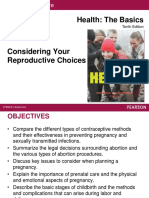0% found this document useful (0 votes)
56 views4 pagesSSP
This document summarizes various contraceptive methods, including hormonal injections administered every 3 months, combined oral contraceptives taken daily, transdermal patches worn weekly for 3 weeks per month, vaginal rings worn for 3 weeks per month, diaphragms and cervical caps inserted before sex with spermicide, male and female condoms used during sex, spermicides applied before sex, fertility awareness methods by tracking fertility signs, and the Lactational Amenorrhea Method for breastfeeding women within 6 months of delivery. Typical use failure rates ranging from 4-23% are provided for each method.
Uploaded by
Hanna FloresCopyright
© © All Rights Reserved
We take content rights seriously. If you suspect this is your content, claim it here.
Available Formats
Download as DOCX, PDF, TXT or read online on Scribd
0% found this document useful (0 votes)
56 views4 pagesSSP
This document summarizes various contraceptive methods, including hormonal injections administered every 3 months, combined oral contraceptives taken daily, transdermal patches worn weekly for 3 weeks per month, vaginal rings worn for 3 weeks per month, diaphragms and cervical caps inserted before sex with spermicide, male and female condoms used during sex, spermicides applied before sex, fertility awareness methods by tracking fertility signs, and the Lactational Amenorrhea Method for breastfeeding women within 6 months of delivery. Typical use failure rates ranging from 4-23% are provided for each method.
Uploaded by
Hanna FloresCopyright
© © All Rights Reserved
We take content rights seriously. If you suspect this is your content, claim it here.
Available Formats
Download as DOCX, PDF, TXT or read online on Scribd
/ 4



















































































